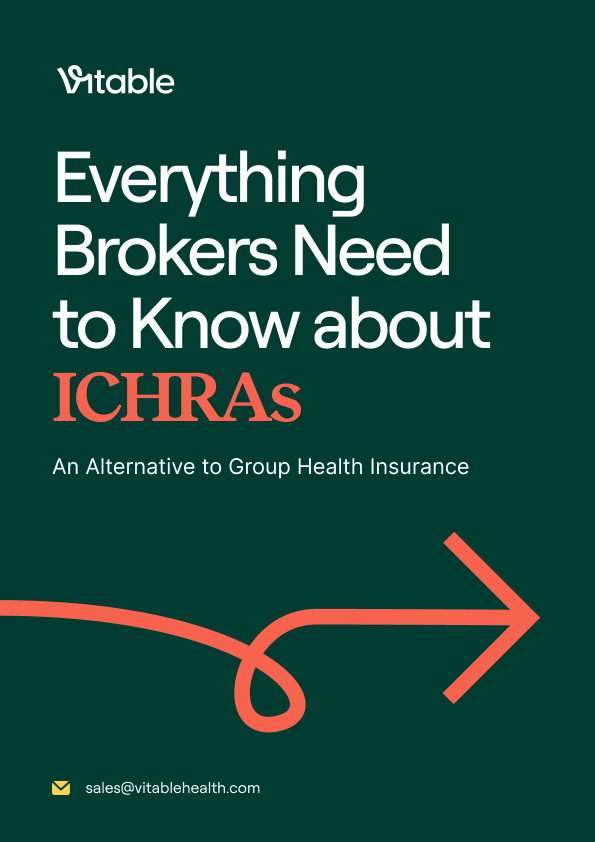What Is the CHOICE Arrangement Act?

Originally introduced in June 2023, the CHOICE Arrangement Act (H.R. 3799) was a proposed bill designed to give employers, especially small businesses, more flexibility in how they offer health benefits to their employees. The bill aimed to expand access to tax-advantaged health reimbursement arrangements (HRAs) and make it easier for businesses to provide affordable, customizable coverage options.
Although the CHOICE Arrangement Act passed the House in 2023, it never advanced in the Senate and ultimately did not become law. However, in 2025, key provisions from the bill were revived and improved under the One Big Beautiful Bill, which passed the House on May 22, 2025, but has yet to be reviewed by the Senate.
In this article, we’ll break down what the original CHOICE Arrangement Act proposed, why it stalled, and how its core ideas are being given new life and potentially a broader impact through the One Big Beautiful Bill (OBBB).
What Is the CHOICE Arrangement Act (H.R. 3799)?
The CHOICE Arrangement Act (H.R. 3799) is a healthcare-focused bill introduced in the U.S. House of Representatives in 2023. It was composed of six distinct sections—or “Titles”—that aimed to expand access to health benefits, especially for small businesses, by improving flexibility, simplifying processes, and strengthening existing reimbursement models like Individual Coverage Health Reimbursement Arrangements (ICHRAs) and Qualified Small Employer Health Reimbursement Arrangements (QSEHRAs).
Here’s a simplified breakdown of what each title included:
Title I – Association Health Plans Act
This section provides the legal authority for Association Health Plans (AHPs) to be treated as a single, large employer under the Employee Retirement Income Security Act (ERISA). This would allow small businesses to band together across state lines to purchase group health insurance, giving them access to better rates and broader plan options. While AHPs have existed under previous DOL rules, this title sought to cement those rules in law and reduce ongoing legal uncertainty.
Title II – CHOICE Arrangement Act
This was the core of the bill. It provided statutory authority to Individual Coverage HRAs (ICHRAs), a model that allows employers to reimburse employees tax-free for their individual health insurance premiums and qualified out-of-pocket medical costs. It aimed to reinforce rules issued in 2019 by federal agencies and aimed to rename these arrangements as Custom Health Option and Individual Care Expense (CHOICE) arrangements.
Title III – Self-Insurance Protection Act
Title III aimed to clarify that stop-loss insurance, used by self-insured employers to protect against high-cost claims, is not considered traditional health insurance under ERISA, and that federal law preempts state laws that would prevent employers from securing it.
Title IV – Small Business Flexibility Act
This section directed the IRS to proactively notify small businesses, especially those in rural areas, about affordable coverage options like ICHRAs, QSEHRAs, and the Small Business Health Care Tax Credit. The goal was to increase awareness and access to flexible, tax-advantaged health benefits.
Title V – Rescissions
Title V aimed to reduce funding from the Prevention and Public Health Fund for fiscal year 2024. This was a cost-saving measure to offset the bill’s proposals.
Title VI – Sense of Congress on Healthcare Freedom
Title VI expressed a general policy statement that Americans should have access to healthcare freedom and free-market choices, reinforcing the bill’s emphasis on employer and individual flexibility in health benefits.
However, none of these were enacted into law, as the original CHOICE Arrangement Act did not pass the Senate.
Is The CHOICE Arrangement Act the same as the “Choice Act”?
It’s important to note that the CHOICE Arrangement Act is often mistaken for “The Choice Act” (Veterans Access, Choice, and Accountability Act of 2014), which relates to education benefits for veterans and their families. Despite similar names, these are entirely different bills with unrelated objectives.
The CHOICE Arrangement Act was solely focused on healthcare reform, specifically, giving employers and employees more flexibility and autonomy in how health benefits are provided and received.
Why Didn’t the CHOICE Arrangement Act Pass?
Although the CHOICE Arrangement Act (H.R. 3799) passed the House of Representatives in June 2023, it never became law because it stalled in the Senate and was never brought to a vote. While the bill generated interest, especially among lawmakers looking to expand healthcare options for small businesses and promote market-driven solutions, it faced several obstacles. The Senate was preoccupied with broader legislative priorities, and healthcare proposals that challenge or shift away from traditional ACA structures often face political resistance. Additionally, with a packed legislative agenda and limited bipartisan momentum, the bill simply didn’t make it onto the Senate floor. Despite this, the core concepts behind the CHOICE Arrangement Act, such as expanding access to ICHRAs, association health plans, and simplified health reimbursement models, continued to gain traction and were later revived as part of the more comprehensive One Big Beautiful Bill in 2025.

Download 2025 Employer Guide to ICHRA
Vitable’s ICHRA Guide gives employers a clear, step-by-step resource for building smarter, ACA-compliant benefits.
This guide explains how ICHRAs work, who qualifies, and how Vitable simplifies setup, onboarding, reimbursements, and compliance — while giving employees more flexibility, control, and care.

Download Vitable’s 2025 Broker’s Guide to ICHRA
The Broker Guide to ICHRAs is a comprehensive resource that helps brokers understand, sell, and manage Individual Coverage HRAs with confidence.
This guide covers everything from compliance and class design to administration flows, case studies, and how Vitable streamlines quoting, enrollments, and reimbursements for brokers, employers, and employees.
A Second Chance: The One Big Beautiful Bill
In 2025, key provisions from the original CHOICE Arrangement Act (H.R. 3799) found new life within a broader legislative package known as the One Big Beautiful Bill (OBBB). While primarily focused on tax reform, the OBBB also includes significant updates to healthcare policy, specifically targeting how employers offer benefits to their workforce.
The bill passed the House of Representatives on May 22, 2025, and as of June 2025 awaits action in the Senate. If enacted, it could reshape how businesses, especially small and mid-sized employers, design and deliver health benefits, making tax-advantaged health reimbursement models more accessible and permanent.
What’s the same?
Although the OBBB is a wide-ranging piece of legislation, it retains several core elements of the original CHOICE Arrangement Act:
- Codification and Renaming of ICHRA: The bill seeks to formalize the ICHRA by giving it permanent legal standing and officially renaming it the Custom Health Option and Individual Care Expense (CHOICE) Arrangement.
- Promotion of Employer-Sponsored Reimbursement Models: The OBBB supports the expansion of health reimbursement arrangements (HRAs), enabling employers to contribute pre-tax funds that employees can use to purchase individual health insurance or pay for qualified out-of-pocket medical expenses.
- Increased Flexibility and Employee Choice: At its core, the goal remains the same: to provide employees with greater control over their healthcare options while offering small businesses a more affordable and scalable alternative to traditional group health plans.
What’s different?
While the original CHOICE Arrangement Act focused solely on healthcare policy, the OBBB integrates these ideas into a much broader legislative package. The healthcare section itself has evolved, offering additional benefits, clarifications, and expanded incentives beyond what H.R. 3799 originally proposed.
Here are some of the key differences:
- Part of a Broader Tax Policy Framework: The healthcare provisions are now woven into a larger tax and economic reform bill, potentially increasing momentum for passage, but also introducing the risk of amendments or political compromise.
- New Small Business Tax Credit: The OBBB introduces a new tax credit for small businesses (fewer than 50 full-time employees) that offer CHOICE Arrangements. This added incentive is designed to improve affordability and encourage adoption among small employers that traditionally struggle with offering health benefits.
- Pre-Tax Deductions for On-Exchange Health Plans: Under the OBBB, employees may be allowed to use pre-tax payroll deductions to pay for individual health insurance plans purchased through ACA exchanges—something that was previously restricted under existing ICHRA rules.
- Expansion of HSA-Eligible Services: The bill also proposes expanding Health Savings Account (HSA) eligibility to include services like Direct Primary Care (DPC). This would give employees even more flexibility in how they spend healthcare dollars and align well with personalized care strategies.
- Updated Regulatory Language and Definitions: The OBBB modernizes language around CHOICE Arrangements, providing greater clarity around employer obligations, compliance safeguards, and employee protections.
To learn about all the changes in the OBBB, read the full bill here.
What This Means for Employers (and What You Can Do Now)
As of June 4, 2025, the OBBB has not been signed into law. While the House passed the OBBB on May 22, 2025, the bill still needs to clear the Senate, where a vote may not take place until July 2025 at the earliest. And even if the bill does pass, most healthcare-related provisions, such as the formalization of CHOICE Arrangements and the new small business tax credit, would not take effect until January 2026. So, what should employers do now?
1. You Don’t Need to Act Immediately
There’s no legal or compliance requirement to make changes yet. But staying informed and getting ahead of the curve can help your organization adapt quickly if the bill becomes law.
2. Current HRAs, Like ICHRAs and QSEHRAs, Remain Fully Available
If your organization already offers a health reimbursement arrangement, such as an ICHRA or QSEHRA, there’s no need to worry—these options remain valid, legal, and beneficial. The proposed legislation would build on these models, not eliminate or replace them.
3. Start Working with an HRA Administrator or Health Benefits Advisor
If you're not already working with an HRA administrator, broker, or benefits provider, now is a good time to engage one. These experts can help you:
- Evaluate your current benefits strategy
- Understand how a potential CHOICE Arrangement might apply to your workforce
- Stay ahead of compliance and eligibility changes
- Seamlessly transition if new rules take effect in 2026
Vitable Health: Your Trusted Health Benefits Partner
At Vitable Health, we understand how complex and fast-changing the health benefits landscape can be, especially for small and mid-sized businesses trying to do right by their workforce. As a trusted health benefits platform and leading HRA administrator, Vitable helps employers offer real, accessible care through health plans tailored to the unique needs of their teams—whether that’s an ICHRA, QSEHRA, or a potential CHOICE Arrangement.
And unlike other providers, every Vitable plan comes standard with our Direct Primary Care (DPC) membership, ensuring your employees receive meaningful care, not just coverage.
With Vitable’s primary care-first model, your team gets unlimited primary care visits, access to 1,000+ free prescriptions and labs, mental health support, and more, all for a $0 out-of-pocket cost to your team.
Ready to Start Offering Better Benefits?
We’re closely monitoring the progress of the One Big Beautiful Bill and the potential rollout of CHOICE Arrangements. As legislation evolves, we’ll continue to provide clear, timely updates to keep employers informed and prepared.
Follow our blog and our LinkedIn for the latest insights, expert guidance, and actionable tips to help you stay ahead of the curve.
Have questions or ready to start offering better benefits? Reach out to our team using the form below.
Ready to learn more?
Stay ahead with the latest insights on healthcare, benefits, and compliance—straight to your inbox.
Get a quote
Get a personalized health benefits quote tailored to your company’s unique needs.
Vitable helps employers provide better healthcare to their employees and dependents by improving accessibility, cost, and quality.
